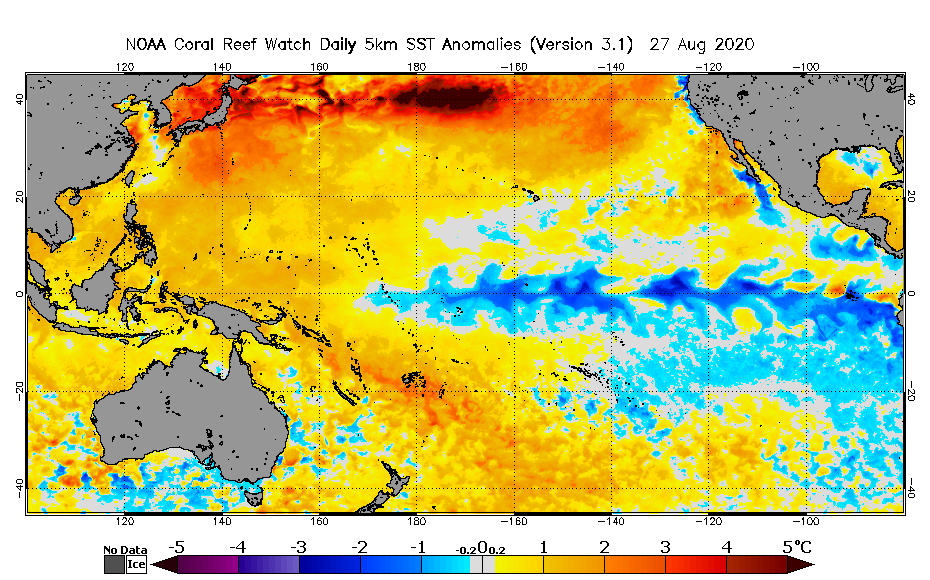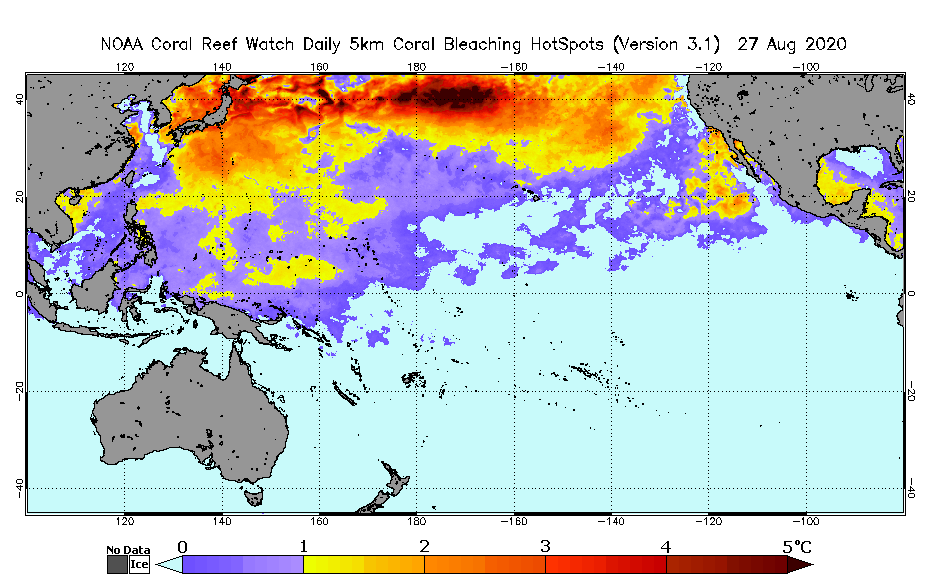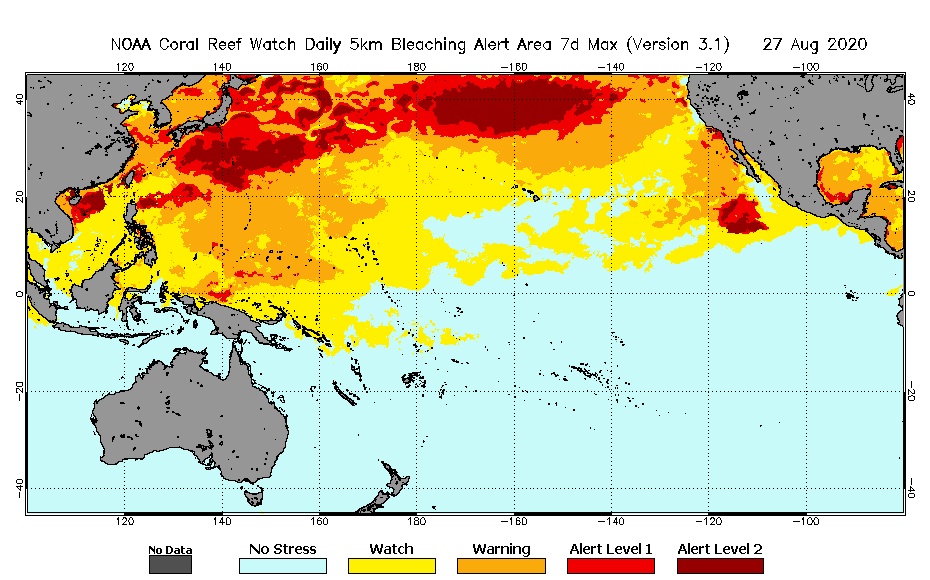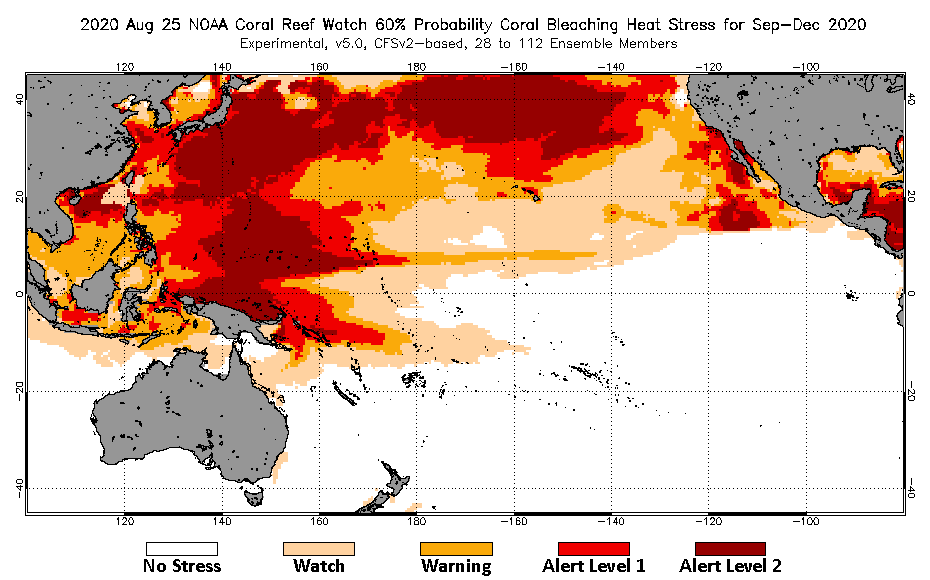Coral Bleaching Heat Stress Analysis and
Seasonal Guidance through December 2020
(Released August 28, 2020)
Current conditions:
NOAA Coral Reef Watch's (CRW) near real-time satellite monitoring shows the sea surface temperature (SST) as alternating between below- and above-average, but predominantly below-average, along the equator in the eastern and central equatorial Pacific; as being below-average in the southeast Pacific; and as being above-average throughout the remainder of the ocean basin (Figure 1). Anomalies remained between one and two degrees above normal for most of June, July and August 2020 around Hawaii, Fiji, American Samoa and Guam. The El Niño Southern Oscillation (ENSO) Alert System status (as of August 13, 2020) is: La Niña Watch. La Niña conditions are slightly favored over ENSO-neutral conditions for August-October 2020.

|
||
|
Figure 1. NOAA Coral Reef Watch's Satellite Sea Surface Temperature Anomaly product for the Pacific region. |
||
Coral Bleaching HotSpots remained consistently low (<1 °C) throughout the Pacific these last few months. Only recently, in August, did they elevate above 1 °C around Guam and the Commonwealth of the Northern Mariana Islands (CNMI) (Figure 2). Bleaching Alert Level 1 and 2 conditions (conducive to significant bleaching, and severe bleaching and significant coral mortality, respectively) diminished around American Samoa in early June, and the majority of the Pacific remained under a Bleaching Watch in June and July (Figure 3). Guam and the CNMI have been under a Bleaching Warning since August. The highest alerts (Alert Level 2) have been concentrated around Taiwan and Japan in the northwest Pacific Ocean, as well as the South China Sea, with Taiwan reporting its most severe bleaching event on record.

|
||
|
Figure 2. NOAA Coral Reef Watch's Satellite Coral Bleaching HotSpot product for the Pacific region. |
||

|
||
|
Figure 3. NOAA Coral Reef Watch's Satellite Bleaching Alert Area (7-day maximum) product for the Pacific region. |
||
CRW's most recent Four-Month Coral Bleaching Outlook (Figure 4) projects heat stress will elevate to Alert Level 2 around Guam and the Federated States of Micronesia by the end of September and likely remain through November. The Hawaiian Islands are expected to be in a Bleaching Warning through most of October and November 2020, with the highest stress happening farther north of the islands around 30 °N latitude.

|
||
|
Figure 4. NOAA Coral Reef Watch's Four-Month Coral Bleaching Outlook of August 25, 2020 for the period September-December 2020 for the Pacific region. |
||
***NOTE: This report incorporates NOAA Coral Reef Watch's Version 3.1 (or v3.1) daily global 5km satellite-based coral bleaching heat stress products and v5 Four-Month Coral Bleaching Heat Stress Outlook.***
To monitor the intensity and location of bleaching heat stress in your coral reef region of interest, please follow NOAA Coral Reef Watch's satellite monitoring and outlooks closely in the coming weeks: https://coralreefwatch.noaa.gov/product/5km/index.php and https://coralreefwatch.noaa.gov/satellite/bleachingoutlook_cfs/outlook_cfs.php.
CRW's current satellite and modeled products can be found at:
https://coralreefwatch.noaa.gov/index.php
CRW's Four-Month Coral Bleaching Heat Stress Outlooks can be found at:
https://coralreefwatch.noaa.gov/satellite/bleachingoutlook_cfs/outlook_cfs.php
CRW's 5km satellite Regional Virtual Stations can be found at:
https://coralreefwatch.noaa.gov/product/vs/map.php
Sign up for automated bleaching alert emails for CRW's 5km Regional Virtual Stations at:
https://coralreefwatch.noaa.gov/subscriptions/vs.php
Please report bleaching events (or non-events) at:
https://coralreefwatch.noaa.gov/satellite/research/coral_bleaching_report.php
Disclaimer
The content posted on this web page solely represents the opinions of the authors and does not constitute a statement of policy, decision, or position on behalf of NOAA or the US Government.
The appearance of external links on this World Wide Web site does not constitute endorsement by the Department of Commerce/National Oceanic and Atmospheric Administration of external Web sites or the information, products or services contained therein. For other than authorized activities, the Department of Commerce/NOAA does not exercise any editorial control over the information you may find at these locations. These links are provided consistent with the stated purpose of this Department of Commerce/NOAA Web site.